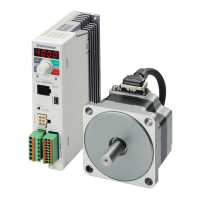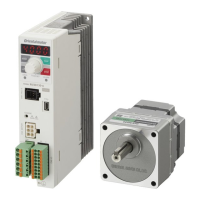12
Connecting an external speed setter
The rotation speed can be set using an external potentiometer (supplied) or
external DC voltage. Connect the external potentiometer to the CN6 on the
driver with the supplied signal wire.
•z
Using an external potentiometer (supplied)
Connect the shielded wire of the signal wire to the VL input terminal and
make sure the shield wire does not contact other terminals.
2 VM input
1 VH input
Yellow
Yellow
External potentiometer
(supplied)
WhiteWhite
Red
Red
3 VL input
123
•z
Using an external DC voltage
For the external voltage, use a DC power supply with reinforced insulation on
its primary and secondary sides.
The input impedance between the VM input and VL input is approximately
30 k
Ω
.
2 VM input
CN6
3 VL input
0 to 10 VDC
1 mA or more
power supply
Note
Be sure to set the external DC voltage to 10 VDC or lower.
When connecting the external DC power supply, make sure
the polarities are correct. If the polarities are reversed, the
driver may be damaged.
Connecting the data setter (CN3)
Connect
OPX-2A
cable or supplied cable with the
MEXE02
to CN3 on the
driver.
cable with the MEXE02
Connecting the RS-485 communication cable (CN7/CN8)
Connect the RS-485 communication cable to the CN7 or CN8 on the driver.
CN7/CN8 pin assignment
Pin No. Name Description
•
1 N.C. Not used
2 GND GND
3 TR+ RS-485 communication signal (+)
4 N.C.
Not used
5 N.C.
6 TR− RS-485 communication signal (−)
7 N.C.
Not used
8 N.C.
Test operation mode
Once a main power supply and 24 VDC power supply are connected, the
connection status can be checked by driving the motor tentatively without
setting the data.
1. Turn on the main power supply and 24 VDC power supply after completing
the wiring.
2. Turn the test operation mode switch (SW2-No.1) ON.
3. Check that the motor rotates at low speed
(100 r/min) in the forward direction.
If the motor did not rotate or malfunction
could be seen, check the wiring after
turning o the power.
(If the rotation direction has been changed by the
OPX-2A
,
MEXE02
or
RS-485 communication, the motor rotates according to the setting.)
4. Turn the test operation mode switch OFF.
The motor stops.
Note
If the FWD input or REV input is turned ON while the motor
rotates in test operation, the motor will stop. (A warning or
alarm signal is not output.) To reset this condition, turn all of
test operation mode switch, FWD input and REV input OFF.
The motor will be able to operate after turning all of them
OFF.
Connecting the regeneration unit
If vertical drive (gravitational operation) such as elevator applications is
performed or if sudden start-stop operation of a large inertial load is repeated
frequently, connect an accessory regeneration unit
EPRC-400P
(sold
separately).
Install the regeneration unit in a location where heat dissipation capacity
equivalent to a level achieved with a heat sink [made of aluminum alloy,
350×350×3 mm (13.78×13.78×0.12 in.)] is ensured.
Connecting method
Connect the regeneration unit before turning on the main power and
24 VDC power. The regeneration unit does not perform its control function if
connected after the main power and 24 VDC power has been turned on.
•
Regenerative current ows through the two thick lead wires
(AWG18: 0.75 mm
2
) of the regeneration unit. Connect them to the RG1 and
RG2 terminals of the TB1. The applicable crimp terminal is the same as the
one used to connect the power supply.
•
The two thin lead wires (AWG22: 0.3 mm
2
) of the regeneration unit are
thermostat outputs. Connect them to the CN5 and CN6.
Regeneration
unit
EPRC-400P
AWG22
and CN6
TH input
IN-COM1
150 °C (302 °F) 㼇N.C.]
Connect to RG1 and
RG2 terminals on TB1
AWG18
R䠖400 Ω
Note
•
If the current consumption of the regeneration unit exceeds
the allowable level, the thermostat will be triggered and the
regeneration unit overheat alarm will generate.
If the regeneration unit overheat alarm generates, turn o
the power and check the content of the error.
•
If an external power supply is used for the power supply
of input signals, turn on the external power supply before
turning on the driver main power supply.

